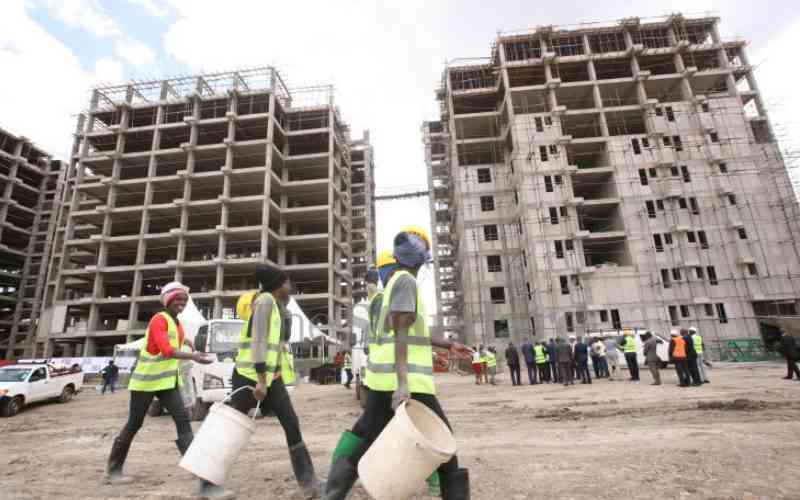Regional financial services provider, Stanlib became the first firm to tap into the Real Estate Investment Trust (REITs) in Kenya. REIT as an investment vehicle allows individuals to invest in large-scale, income-producing real estate.
Opening at a nominal value of Sh20 for each unit and a minimum subscription of Sh20,000 (1,000 units), Stanlib Fahari I-REIT public offer gives investors the opportunity to make gains through capital appreciation and rental income distributed annually.
Stanlib’s regional Director James Muratha said the firm has been planning for the product for the past three years, most of this period going into research and product development. “The aim of Fahari is to present a new model of investing in real estate that is demanded of us in the current economic trends in the country,” said Mr Muratha.
The same model has been credited with the development of South Africa’s Sandton City, Africa’s largest retail shopping centre owned by Stanlib’s parent company Liberty Group. The launch of Fahari i-Reit also coincided with the Nairobi Security Exchange’s launch of the REIT making Kenya home to the third exchange in Africa where investors can trade in sub-parts of the Kenya’s multi-billion property market.
This is part of renewed efforts by Kenya to tackle the systemic problem of high costs of housing development and make home ownership affordable to the mid-to-low income earners who form the majority of the population.
Data from the 2015 edition of the economic survey indicates that the average price of private residential buildings in Nairobi has surged by 60 per cent from an average of Sh30 million in 2010 to Sh50 million as at last year. Kenyans looking for residential commercial buildings on the other hand have also been hit with a more than 100 per cent surge in prices from Sh4.5 million in 2010 to Sh8.3 million as at last year.
Kenyan incomes on the other hand have dipped in both the public and private sector by 8 per cent from an average of Sh380,000 per year in 2010 to Sh350,000 per year in 2013. Because of this, home ownership has remained elusive for many in the country where majority are low income earners.
According to data from the Central Bank of Kenya (CBK) there were 22,000 residential mortgages valued at a combined Sh164 million as at December last year; dismal figures in a country with more than 28 million deposit accounts. Respondents to a mortgages housing survey conducted by CBK last year cited high cost of housing, at 22 per cent, as the largest obstacle to adoption of mortgages.Another 21 per cent cited high interest rates while 15 per cent blamed high incidental costs including legal, valuation and stamp duty fees as discouraging factors to home ownership.
The quest to provide affordable housing has become harder today in part owing to the government’s failure in maintaining solid urban housing system, which kicked off in the early 70s.
Private-sector-driven
The National Housing Corporation (NHC) was meant to be the primary driver of government-led affordable housing development before it lost it’s mandate together with other parastatals in the 80s and 90s. The 1968/76 National Housing Policy promoted a strong role for the government in providing affordable housing for the citizens spearheaded by NHC with help from municipal councils and civil service housing schemes. At this time, one in two wage earners were public sector employees and the result of this was the development of estates like Harambee, Maringo, Kaloleni, Buru Buru, Ngara, Madaraka, Jamhuri among others that provided decent housing for mid-to-low income earners at affordable prices.
However, when the rural to urban migration kicked off in the 1970s, this led to a deterioration of housing situation as demand rapidly outstripped supply amid an economic slump. This saw the Government push affordable housing development to the bottom of it’s priority list opening the door for a free-for-all private-sector-driven housing development regime that prevails to this day.
Anthony Mugo is the managing director of Ng’ando Development, a new company that connects land owners in peri-urban areas of Nairobi with financiers and property developers to maximise on the value of their properties. Mugo recently completed a deal with Shelter Afrique to construct a Sh500 million eight-storied apartment block with 64 units in Ngong’s Racecourse area. About 25 per cent of the property has been sold.
“The demand for housing among the mid to low tier income earners in Kenya has always been very high especially now when the cost of construction is going up pushing prices even higher,” explains Mr Mugo.
He further states that while it was possible to get an acre of land along the Racecourse area for around Sh40 million in 2013, the same plot of land today is going for at least Sh100 million. “In real estate you need to have a demonstrated demand for developing a particular property,” explains Mr Mugo. “Most Kenyans prefer to live in and around where they work. That is why rent yields and property prices in estates close to Nairobi’s CBD have always been high.” Mr Mugo who studied construction management at the Jomo Kenyatta University of Agriculture and Technology suggests a model of moving away from the city and creating urban centres that are fully sufficient while at the same time maintaining low unit prices.
Stay informed. Subscribe to our newsletter
Set up amenities
“Many developers are still afraid to go downstream but we have demonstrated that you can find ways of making savings through finding affordable capital and construction inputs,” he explains.
Mr Mugo says that Ngong Road is an example of an economic hub whose potential has yet been fully exploited owing to the past reluctance of developers to adopt new-age approaches to developing low cost housing. The company is planning to have a total of 320 new units targeting middle-income earners in Racecourse, which will be phased out in the next few years.
“The next step is to reach out to supermarkets, schools and health centres to set up amenities around these areas because people living there are going to need them,” he added. “I showed this plan to one of the financiers and he did not tell me he’ll look at it, it was more like, when can we get on board?”
—[email protected]
 The Standard Group Plc is a
multi-media organization with investments in media platforms spanning newspaper
print operations, television, radio broadcasting, digital and online services. The
Standard Group is recognized as a leading multi-media house in Kenya with a key
influence in matters of national and international interest.
The Standard Group Plc is a
multi-media organization with investments in media platforms spanning newspaper
print operations, television, radio broadcasting, digital and online services. The
Standard Group is recognized as a leading multi-media house in Kenya with a key
influence in matters of national and international interest.
 The Standard Group Plc is a
multi-media organization with investments in media platforms spanning newspaper
print operations, television, radio broadcasting, digital and online services. The
Standard Group is recognized as a leading multi-media house in Kenya with a key
influence in matters of national and international interest.
The Standard Group Plc is a
multi-media organization with investments in media platforms spanning newspaper
print operations, television, radio broadcasting, digital and online services. The
Standard Group is recognized as a leading multi-media house in Kenya with a key
influence in matters of national and international interest.








